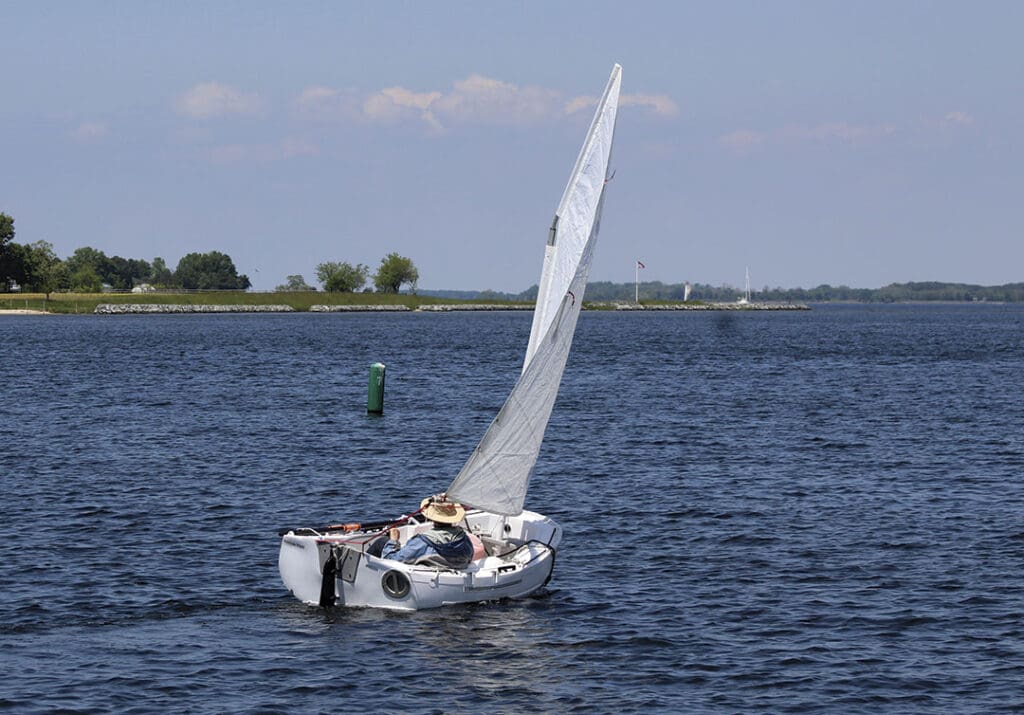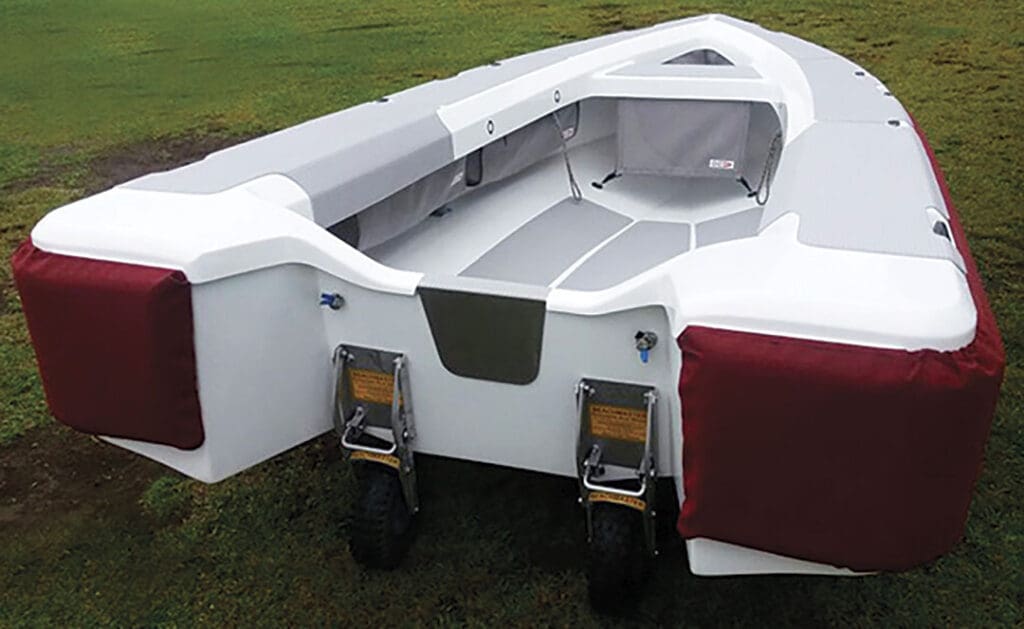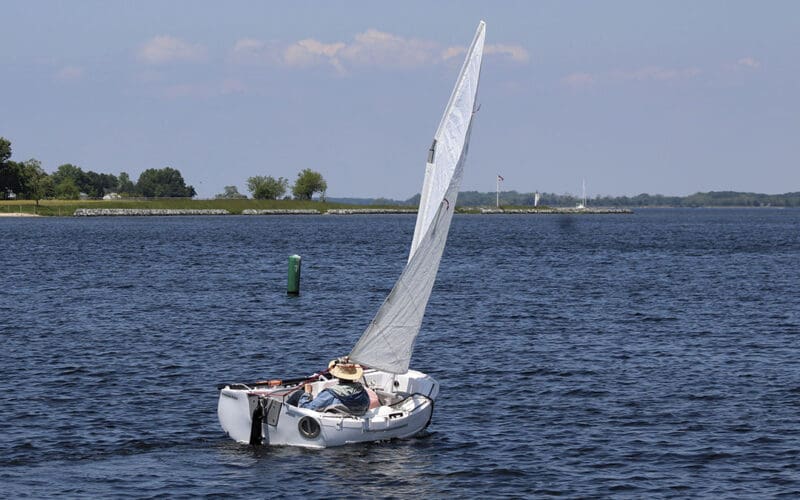
Once we leave sight of land on our offshore sailing adventures, there is always a question looming over us: what if we hit something and have to abandon ship immediately? While the odds of this happening are infinitesimally small, we’ll sleep better if we have a solid, dependable lifeboat we can jump into for survival.
The Portland Pudgy, manufactured in South Portland, Maine, is a top-quality, multi-purpose dinghy designed with both comfort and stability in mind, especially for rough conditions. This is a dinghy you can sail, row or motor, covering a lot of bases for avid offshore and coastal cruisers.
One quick look at a Portland Pudgy reveals a stout, tough, all-weather, compact vessel with surprisingly ample storage space for food and water if needed in an emergency. Sitting inside a Pudgy, you are surrounded on four sides by buoyant chambers with large portals for storing supplies.
You will marvel at every attention to detail going into the design and construction of the Pudgy: a built-in compass, placement of tow-eyes and grab-lines, textured gunwales and floor, drain gutters, drain plug and more. All of this in a boat measuring 7 feet, 8 inches long, 4 feet, 4 inches wide, and 2 feet, 4 inches deep.

Owing to the great amount of storage and internal flotation, the interior length is a comfortable 6 feet, 2 inches long with a total of 16.1 square feet of space. The Portland Pudgy is a USCG-approved vessel with a carrying capacity of 557 pounds, enough for two or three crew members, an outboard motor, navigation gear, food and water.
Other features include two collapsible oars with sleeves and collars, a Richie illuminated compass, towing bride harness, tethered drain plug, three seats with polyethylene hand-holds, stainless steel oarlock sockets and double roller wheels for easy storage on land.
Russel and Karin Carlyon of OC Tenders in Bay of Islands, New Zealand, began their foray into dinghy construction while looking for a solid offshore tender with the ability to perform as a fast, inshore sailing dinghy. Russel, who has a strong background as a windsurfer, had the structural insight to envision a tough, small vessel capable of withstanding offshore conditions in an emergency.
Among the features of the OC Tenders product line is, first and foremost, its carbon fiber construction, which yields a light but strong hull and deck structure, and non-skid surface on the deck and cockpit floor.
You will appreciate OC Tenders’ design with a tank bulkhead, pockets, two seat blocks, large drainage bung, standard davit lifting eyes, thick rub strake, floating painter, tiller extension and a pair of oars and oarlocks. Each model also comes with an anchor kit, so you won’t need to drag your OC Tender over gravel or rock shingle in order to enjoy some time ashore.
OC Tenders builds a total of five models of dinghies for offshore cruisers, ranging from its OC270 at just under 9 feet, to the OC400, which measures nearly 13 feet in length. Accessories include navigation lights, custom color rub rail cover, fishing rod holders (sold separately in pairs), an extendable ladder and retractable wheels.
Backwater Boats in Surrey, British Columbia, produces fun, affordable dinghies for use as both tenders and all-around recreational boats in protected water. Although not recommended as a lifeboat, this lightweight dinghy molded of durable plastic is easy to transport, whether on the bow of your main vessel, in the back of a pickup truck or on the roof rack of your car.
The Backwater dinghy measures 7 feet, 8 inches long, weighs 68 pounds unequipped and has a carrying capacity of 352 pounds, which equates roughly to two people plus cargo and equipment. All seats, which contain high-density flotation foam, are removable for storage and stacking, and cup holders are located at convenient points in the dinghy.
If you prefer motoring, you can purchase an optional set of aluminum and plastic plates to mount an outboard of up to 2.5 horsepower on the Backwater’s transom. Each Backwater dinghy is thermoformed from a single sheet of highly durable plastic, which the company claims is stronger than wood or fiberglass. Therefore, you can expect the transom to be up to the task of handling the extra weight and torsion of an outboard motor.
If you prefer rowing, you can pull yourself to shore with a pair of 65-inch, two-piece aluminum oars, which are collapsible to 34 inches for storage. The oarlocks are of a proprietary design, so it would be wise to order an extra pair as replacements if you are preparing for a long offshore voyage.
Before taking the plunge with the purchase of a new, hard-shell dinghy, take time to weigh the options in buoyancy, construction materials, durability and usability as both tender and lifeboat, unless you already have an emergency inflatable packed in a box on the foredeck for that purpose.
There are numerous other lines of high-quality, solid-hull dinghies on the market. Review all of these designs and features carefully and invest in the product best suited to the demands of your coastal or offshore cruising itinerary. n

